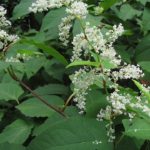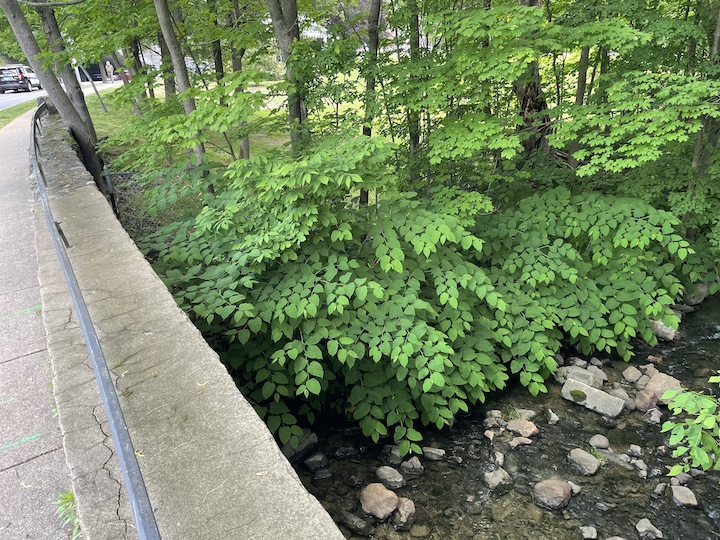
By Jeffrey North
Invasive plant species are disrupting ecosystems from Belmont to Beijing, permanently altering the ecology of our forests, fields, and gardens and causing biodiversity loss and species extinction. This article is the third in a series on invasive plant species found in Belmont, the implications of their presence, spread, and ecological damage potential, and hopes for their removal and remediation.
Japanese knotweed (Polygonum cuspidatum), also known as Asian knotweed, is native to Japan, China, and Korea. It is frequently found on the sides of volcanoes, where it breaks down igneous rock into new soil. You might think it was native in some places in North America (and Europe) too. Brought to these shores from England in the 1880s, Japanese knotweed was grown as a curiosity as an ornamental plant and, ironically, for erosion control. It is currently found in most states, throughout Canada, Europe and even in southern stretches of Chile approaching Patagonia.
This dense-growing shrub can reach 10 feet and resembles bamboo. Japanese knotweed commonly invades disturbed areas with lots of sunlight such as roadsides, stream banks, and shorelines, but can also grow in full shade, and it has a high tolerance for drought, temperature swings, and salinity. The plant is easy to spot, with its (hollow) bamboo-rhubarb look-alike stalks. The stems are smooth, stout, and hollow. The leaves measure about six inches long by four inches wide, oval to somewhat triangular in shape. Japanese knotweed’s white flowers emerge in summer; its fruits are winged on three sides; its seeds are triangular, dark brown, shiny, and about 1/10-inch long. Look-alikes include Virginia knotweed (Tovara virginiana), and two exotic invasive relatives: prince’s feather (Polygonum orientale) and giant knotweed (Polygonum sachalinense).
The Problem
Japanese knotweed is changing the character of the woodland edges and the banks of our streams. Knotweed can crowd out native herbaceous species, depriving the natives of light, moisture, nutrients, and space. The weed destabilizes soil, most notably on the banks of streams, where the soil is too often carried away during storms and snow melt. This erosion changes the course of the stream as it sends silt into the water to be deposited downstream as water quality is sullied.
Reproduction occurs every which way. It spreads by its tentacle-like rhizomes (lateral growing roots), via seed dispersal, and simple cuttings or fragments carried by wind, water, shoes, or birds. When cut or disturbed, regrowth is rapid and robust. This plant is thus extremely difficult to eradicate.
Japanese knotweed invades a wide variety of habitats and forms dense stands that crowd out other plants. Dense thickets are routinely found along roadways, stream banks and abandoned and disturbed areas, and increasingly in our gardens and among landscape plantings.
What not to do
Do not attempt to pull Japanese knotweed out of the ground. The plants’ root systems are extensive (up to 20 feet in length) and deep (up to 10 feet deep) for established patches of the weed. Pulling or digging up the stalks usually results in a rapid, vigorous regrowth as the plant returns seemingly stronger than the original weed patch.
Do not compost Japanese knotweed. Even burning might not destroy the plant’s zombie-like ability to return.
Repeated cutting of leaves and stalks might be effective for young plants in new infestation patches, but typically, the roots need to be killed for effective remediation. Even deep digging with an excavator usually fails to remove all the root fragments, and the plant returns with a vengeance.
Meanwhile, disposing of the infested soil is problematic due to the presence of root fragments. Try covering a patch with black weed block and watch the sharp stems puncture even thick plastic, ot watch it poke through tiny cracks in concrete or asphalt.
The Solution
Chemical treatment can be effective if repeated with a systemic herbicide, particularly if the stems are cut and injected, a very labor-intensive initiative. Eliminating Japanese knotweed is a multiyear campaign. Start by cutting the plants in late June or early July, then treat the regrowth with a foliar spray of a systemic herbicide in late August or early September.
Control of invasive plants in wetlands is subject to the Massachusetts Wetlands Protection Act. Check with the Belmont Conservation Commission before implementing control measures, and only use herbicides registered for use in wetland areas. There is no shame in seeking professional help.
New experimental treatments include soil sterilization using steam, applying seawater, and biological control using certain fungi or insects. Goats will eat the stalks and pigs will root up the rhizomes, but these measures are only practical in a few areas. So far, no magic bullets exist to kill knotweed.
The following native plants can serve as good replacements to knotweed in a garden:
New England Aster (Aster novae-angliae)
Blue False Indigo (Baptisia australis)
Sweet Joe-Pye-Weed (Eupatorium purpureum)
Queen-of-the-Prairie (Filipendula rubra)
Source: Concordma.gov/783/Japanese-Knotweed
Jeffrey North is the ex officio Belmont Conservation Commission representative on the Land Management Committee for Lone Tree Hill and managing editor of the Belmont Citizens Forum Newsletter.




Sorry, the comment form is closed at this time.